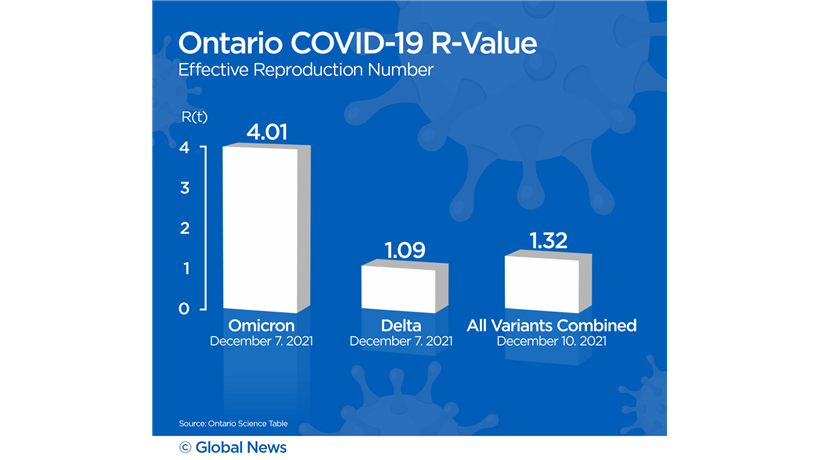The transmissibility of the Omicron COVID-19 variant in Canada — where it may soon become the dominant strain — is seen as potentially problematic by infectious disease specialists.

In Ontario, the only province that has tracked its reproductive rate (R value), the variant is infecting almost four times as many people as the Delta variant.
“It’s safe to say that this is a very fast-moving variant that’s rapidly taking over and will be probably the dominant variant here in Ontario by the end of this week,” said Dr. Isaac Bogoch, an infectious disease specialist at Toronto General Hospital.

In Ontario, recent data released by the Science Advisory Table shows the R value for Omicron at 4.01, which Dr. Andrew Morris, an infectious disease specialist at Mount Sinai Hospital, said was “unprecedented” in that it has never reached that high at any time during the pandemic. Comparatively, the Delta variant has an R value of 1.09. Both variants combined were last recorded at 1.32 on Dec. 10.
The R value for the variants combined shows the pandemic is not yet over, but the Omicron figure paints a starker image – that if preventative measures are not enacted the pandemic could spiral out of control.
Essentially, one person would be infecting four people, who would then infect 16 and then 64 people who would infect 256 people and so on. The doubling effect would occur every five days.
If the R value were to hold true, it could cripple the Canadian health system in a few months, as millions of Canadians would be infected and re-infected with COVID.
What is the R value of COVID-19?
The closer the reproductive rate — also known as “R number” — is to zero, the better. The lower the number, the less the virus is spreading in the community, which means hospitals are less overwhelmed and intensive care units are not exceeding their capacity.
The R value describes how many people one COVID-positive person can infect; if one person infects only another person, the R is one. If one person infects two people, then the R value is two. The higher the R value, the faster the spread.
“If you have a reproduction number of one, it means that one person will then pass it on to somebody else. Essentially, you’re at a steady state … even though it may be growing over time, it’s very slow and steady,” said Morris, a member of the Ontario Science Advisory Table for COVID-19.
The R value is a strong indicator of whether a pandemic is dying down or ramping up, Bogoch said, and if Canada does not respond with the proper restrictions, the situation could become disastrous.
“If your R value is less than one, you’ve got a shrinking epidemic. If your value is greater than one, you’ve got a growing epidemic,” said Bogoch. “If your value is higher than the number one, the faster the epidemic is growing.”

Morris likens the R value to social media. He said if you have only one follower on social media, you cannot make that much of an impact. But, if you have a larger following, your ability to go viral is a lot more likely as there are more people to amplify a single message. That person with a large following would be like someone in real life who meets with a lot of contacts, or attends large events and becomes someone who could infect a high number of Canadians.
How is R value measured?
The R value cannot be captured in real-time, so instead, data is used to understand the problem usually over a seven- or fourteen-day span. Data from different resources, including the number of people being infected, admitted to hospitals or who have died, are used to determine the spread of the virus.
In the most recent modelling data presented on Dec. 10, the Public Health Agency of Canada’s data showed the R value of COVID-19 in Canada was at 1.11. Data up until Nov. 27 was used to determine the R value. The agency’s modelling data did come with some caveats and warned that the R value “may not capture the current state of the epidemic.” If cases are very low and then suddenly spike by a few hundred, it could artificially inflate the R value.
“R is highly sensitive to the reported number of new cases, community outbreaks within specific provinces and territories will cause the estimated R value in that respective region to be higher, which may not always accurately depict overall transmission in the province or territory as a whole,” they wrote in the modelling report.
But Morris said that’s not what is happening in Ontario or across Canada. He noted that there is significant spread across the country with a high number of cases and the R value continue to spike up, which is troublesome.
Outside Ontario, only three provinces record their R value on a regular basis. In Alberta, where military intervention is still underway for COVID-19, the province’s R value is averaged at 0.96 with data from Nov. 29 to Dec. 12.
Quebec, which regularly reports the R value every two weeks, found their figure to be on the higher end with a 1.24 as of Dec. 12.
B.C. released its data on Dec. 2 showing the R value in the province sitting at 0.99, just a hair under one. The province is expected to release more recent data Tuesday afternoon.
Concerns around Omicron R value holding true
If the Omicron R value holds true, Morris said it would be “catastrophic” to the health-care system.
There are preventative measures that could be used to limit spread. From lockdowns, social distancing, masking and reducing in-person contact – all these measures would reduce and limit transmissibility. If the measures are not put into place and used strictly, and if the R value of Omicron indeed exceeds that of Delta, the toll the variant could take on the health care system would be severe.
“If the growth rate is aggressively high and quick, and if it results in a fair number of hospitalizations, it will be very difficult for the health-care system to absorb those numbers,” he said.

Morris added that Ontario’s health system can handle hundreds of patients at any given point, but when the number crosses over into four digits, it could become worrisome.
“If there were a thousand (patients) in a week, that would be pretty challenging,” he said.






Comments